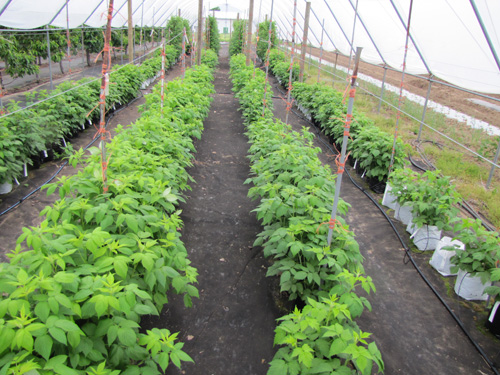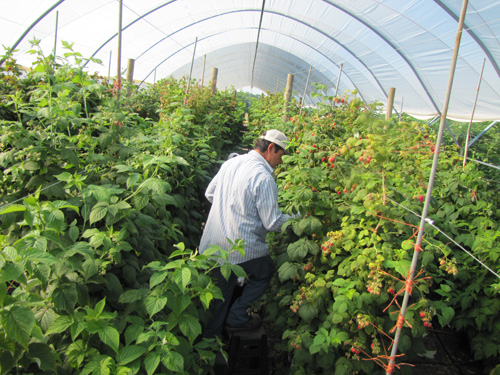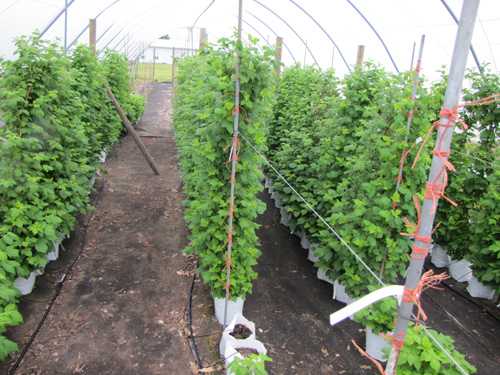Growing potted raspberries in high tunnels
Learn about growing potted raspberries in high tunnels.
We have been working with a potted growing system to quickly screen cultivars for suitability in high tunnels, and also to evaluate commercial potential for potted raspberry culture. Potted culture may have value where soils contain chemical contaminants or are infested with pathogens, or where growers wish to move plants to make efficient use of tunnel space. The work is funded partly by the Michigan State Horticulture Society Trust Fund.
Eight primocane-fruiting (fall fruiting) cultivars (Anne, Autumn Britten, Caroline, Himbo Top, Jaclyn, Joan J, Josephine, Polka) were potted in 2011 in three gallon black plastic Gro-bags filled with a mix of 70% composted pine bark and 30% peat. Joan Irene, Nantahala, Crimson Giant and the proprietary cultivar Erika, and two floricane-fruiting types (Encore, Nova) were added in 2012. Crimson Giant plants were received early and grown in a greenhouse before they were transplanted to Gro-bags and moved to the tunnel in June. Plants of Erika were received late and placed in the tunnel on 8 June.

Raspberry plants were planted in three gallon plastic Gro-bags
Plants have been grown in a 200 x 24 ft high tunnel bay covered with plastic from May to late October. We have utilized shade fabric over the plastic at different times to moderate temperatures and light. Plants were drip irrigated with one 0.5 gph emitter per pot. Schedules varied in 2011 as we determined water demand. Plants were watered six times per day for 30 minutes per time (2012) or 20 minutes (2013). Nutrition was supplied with a small amount of Osmocote early in the season and continuous fertigation through the trickle system thereafter, delivering approximately 100 ppm nitrogen using commercial soluble fertilizer.
Plots were harvested every 2 to 5 days from 25 Aug to 3 Nov, 2011, 11 July to 20 Oct, 2012, and 15 July to 18 Oct, 2013 (floricane-fruiting types from 1 July to 9 Aug, 2013) to determine yields and average berry weight. Half pint clamshell samples were collected on several dates and evaluated for appearance and percent mold after 6-24 hr at 2C and 24-48 hr at 18C.

Harvesting plots to determine yields and average berry weight
During the 2011-12 winter, half of plants were stored in a cooler and half were stored outside. Survival was nearly 100%. During the 2012-2013 winter, all plants were piled about three high on site and covered with a nursery fabric. Again, few plants were lost. All canes of the primocane fruiting varieties were pruned out before stacking. The floricane fruiting varieties were pruned to retain two 5-6 ft tall canes per plant.

The floricane fruiting varieties were pruned to retain two 5-6 ft tall canes per plant.
Shelf life and fruit quality
Half-pint clamshell samples stored for a short time to simulate commercial handing were rated for overall appearance on a scale of 1 ( non-salable) to 5 (excellent with no defects), and sorted to determine the percentage with visible mold (Table 1). Appearance was rated lower for irregular shaped or colored berries, presence of mold, or excessively dark color. Few differences were apparent in appearance, although Polka and Erika fruit were rated high due to a uniform lighter red color. Jaclyn, Caroline and Josephine appeared to have less incidence of gray mold. Taste is subjective, but we provided some general impressions (Table 1). Some varieties we generally rated as very tasty were Jaclyn, Joan J, Polka, Josephine, Nantahala, Joan Irene and Erika.
| Variety | Appearance 2012 | Appearance 2013 | Rot (%) | Rot (%) 2013 | Comments |
|---|---|---|---|---|---|
| Jaclyn | 3.7 | 2.8 | 1.5 | 2.7 | dark to v dark, slight discoloration, dull, firm to v firm, good to excellent flavor |
| Joan J | 3.7 | 2.8 | 1.5 | 2.7 | dark to v dark, discolors some, slight gloss, firm, good to excellent flavor |
| Autumn Britten | 3.3 | 3.2 | 5.3 | 6.7 | medium red, discolors some, some gloss, soft to medium firm, good flavor |
| Polka | 4.3 | 4.4 | 3.4 | 2.0 | medium red and glossy, little discoloration, firm, excellent flavor |
| Himbo Top | 3.8 | 4.1 | 1.0 | 2.6 | medium red, glossy, little discoloration, soft to med firm, average flavor |
| Caroline | 4.2 | 3.6 | 1.6 | 0.6 | med red to slightly dark, little discoloration, some gloss, somewhat soft, good flavor |
| Josephine | 3.7 | 3.3 | 2.6 | 0.9 | darker red, little discoloration, dull, firm to v firm, good to excellent flavor |
| Anne | 3.5 | 3.6 | 4.2 | 2.3 | yellow, discoloration, medium gloss and firmness, good flavor |
| Nantahala | - | 3.0 | - | 6.7 | medium red, little discoloration, dull, medium firm, good to excellent flavor |
| Joan Irene | - | 3.1 | - | 0.8 | dark to v dark, little discoloration, firm to v firm, excellent flavor |
| Crimson Giant | - | 2.5 | - | 14.1 | medium red, irregular color, glossy, soft (poor adhesion), weak flavor (some off-flavors) |
| Erika | - | 4.0 | - | 3.9 | light to medium red, no discoloration, medium firm, good to excellent flavor |
Yields
Highest yielding types planted in 2011 have been Joan J, Caroline and Himbo Top. Yields were modest in 2011, partly due to wind and periods of water stress. Production from all varieties was higher in 2012 and 2013 due to improved irrigation scheduling and the use of a 30% shade material placed over the tunnel plastic in the summer to moderate sun and temperatures. Yields of varieties planted in 2012 (Nantahala, Joan Irene, Crimson Giant, Erika) have been relatively low, partly because they are late fruiting types and we have not attempted to prolong the harvest season by enclosing the tunnel in the late fall. Yields of these types would have been increased by lengthening the picking season The two floricane fruiting types (Nova, Encore) were harvested for the first time in 2013 and yield similar amounts as the better primocane-fruiting varieties.
At our plant spacing, an acre would contain about 6,200 plants, so a yield of 3.0 lb per plant would equate to over 18,000 lb per acre.
| Cultivar | 2011 | 2012 | 2013 |
|---|---|---|---|
| Jaclyn | 0.8 | 1.9 | 2.2 |
| Joan J | 1.1 | 3.1 | 3.2 |
| A Britten | 0.8 | 1.9 | 1.7 |
| Polka | 1.1 | 2.5 | 2.3 |
| Himbo Top | 0.9 | 2.5 | 2.9 |
| Caroline | 1.0 | 2.9 | 2.7 |
| Josephine | 0.9 | 2.3 | 3.2 |
| Anne | 1.1 | 2.5 | 2.7 |
| Nova | 3.0 | ||
| Encore | 2.7 | ||
| Nantahala | 0.4 | 2.6 | |
| Joan Irene | 0.1 | 2.3 | |
| Cr. Giant | 0.5 | 1.2 | |
| Erika | 0.1 | 2.6 |
Pests, diseases and disorders
Spotted wing drosophila (SWD) adults have emerged in July, causing significant damage and some yield losses, and numerous sprays for control. Other pests have included spider mites, potato leafhoppers (most severe on Polka), botrytis mold (worst on Anne, Crimson Giant and Himbo Top) and animals chewing the drip lines. Late leaf rust was observed on Jaclyn, Joan Irene and Josephine, but it never affected the fruit. Powdery mildew was also present on leaves but not fruit. Foliar symptoms were moderate on Nantahala, and light on Encore, Nova and Erika. Doubling of fruit was observed on Autumn Britten and Nantahala.
Economics
Inputs and potential revenues were summarized based on our experiences. The production system is very labor intensive, but potential revenues are significant as well. On a per acre basis, the initial investment is paid for after the first season. Annual profit for year 2 and later is $15,000 per acre. For this production system to be attractive commercially, some alterations in irrigation and trellis system design and plant training are needed, in order to reduce seasonal labor needs. For detailed budgets, write to Eric Hanson (hansone@msu.edu).